 Logical Systems, Inc. d/b/a Logical Systems, LLC v. Edgar Berrios, Individually and As Next Friend of CA.B., Cesar Berrios, and Estela A Quintos Lopez (No. 05-23-00662-CV; February 9, 2024) arose from an accident in which Plaintiff Edgar Berrios’s arm was severed while using a machine designed by Logical Systems and other defendants. Plaintiffs alleged that the machine was defectively designed, causing Berrios’s injury and associated economic and noneconomic damages. Plaintiffs subsequently amended their pleadings twice. Ten months into the case, Defendant Logic moved to dismiss with prejudice because Plaintiffs failed to submit a certificate of merit that complied with § 150.002, CPRC. The trial court dismissed Plaintiff’s claims without prejudice. It also allowed Plaintiffs to amend to cure the defective report. Defendant appealed.
Logical Systems, Inc. d/b/a Logical Systems, LLC v. Edgar Berrios, Individually and As Next Friend of CA.B., Cesar Berrios, and Estela A Quintos Lopez (No. 05-23-00662-CV; February 9, 2024) arose from an accident in which Plaintiff Edgar Berrios’s arm was severed while using a machine designed by Logical Systems and other defendants. Plaintiffs alleged that the machine was defectively designed, causing Berrios’s injury and associated economic and noneconomic damages. Plaintiffs subsequently amended their pleadings twice. Ten months into the case, Defendant Logic moved to dismiss with prejudice because Plaintiffs failed to submit a certificate of merit that complied with § 150.002, CPRC. The trial court dismissed Plaintiff’s claims without prejudice. It also allowed Plaintiffs to amend to cure the defective report. Defendant appealed.
In an opinion by Justice Smith, the court of appeals affirmed in part and reversed and remanded in part. Defendant argued that the trial court abused its discretion by dismissing Plaintiffs’ claims without prejudice and allowing them the opportunity to cure. As to the question of prejudice, the court held that the statute, § 150.002(e), specifies that dismissal “may be with prejudice,” leaving it to the discretion of the trial court to “determin[e] whether to dismiss with or without prejudice.” Applying an abuse of discretion standard, the court concluded that in this case the trial court did not abuse its discretion by dismissing without prejudice because “nothing in the record as of the time of the dismissal leads us to conclude that the trial court’s action . . . violated any guiding rules or principles so that its action as to the dismissal was arbitrary and unreasonable and an abuse of discretion.” However, the court found that the trial court did abuse its discretion by giving Plaintiffs the opportunity to cure the defect in the certificate, reasoning that “because a dismissal is equivalent to a suit never having been filed, and thus, as a result of the dismissal, [Plaintiffs] no longer had any pleading against [Defendant] to amend.” To rule otherwise, the court added, would violate the statute because “Chapter 150 contains no indication that a trial court may dismiss a claimant’s claim while simultaneously allowing a claimant to amend its pleading to cure the defect that led to the dismissal.” In other words, a court may not treat a Chapter 150 motion to dismiss as a special exception to Plaintiffs’ pleading.
Justice Molberg, joined by Justice Reichek, concurred but expressed concern that Defendant waited for several months until limitations allegedly expired before it moved to dismiss under Chapter 150. Prior to the motion, Defendant did not challenge the certificate [which named other engineering firms but not specifically Defendant] and did not argue that it played any role in the defective design of the machine. It further conducted significant discovery, sought to designate responsible third parties, and “generally conducted itself in a manner inconsistent with a claim of entitlement to early dismissal under [Chapter 150].” Justice Molberg would rule “that in a design-defect case, as long as the certificate of merit reflects an expert opinion that the design was defective, and the designer defendant was appropriately provided a copy thereof, it ought not matter, for § 150.002 purposes, which of the designers the certificate specifically names.” However, since no party appealed the substantive issue, the court could do no more than it did, which, according to Justice Molberg, “represents an obnoxious example of the law being used to elevate form over substance and early dismissal over reasoned justice.”
Whether Justice Molberg is right may be debated, but the real issue here is that no one on the Plaintiffs’ side appealed the dismissal of their claims against Defendant. Consequently, though in a footnote the court expressed “grave concerns about the dismissal based on the record before us, the design-defect nature of [Plaintiffs’] against [Defendant], and the underlying purpose of the certificate of merit requirement,” it couldn’t do anything about it.


